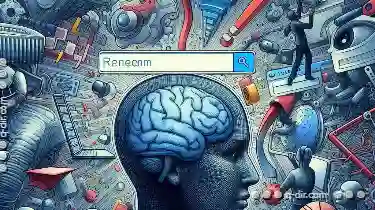Navigating through the vast expanse of the internet can be a daunting task, especially when you're trying to recall specific websites or information ...
 quickly. It often feels like we are caught in a cycle where our web browser's address bar seems to pull us back into familiar but unproductive habits. This blog post will delve into the psychology behind why the address bar keeps users trapped in certain websites and explore strategies to break free from this habit loop.
quickly. It often feels like we are caught in a cycle where our web browser's address bar seems to pull us back into familiar but unproductive habits. This blog post will delve into the psychology behind why the address bar keeps users trapped in certain websites and explore strategies to break free from this habit loop.1. The Power of Habit: How the Address Bar Fuels Routine
2. Cognitive Dissonance: Why We Resist Change
3. The Role of Convenience vs. Exploration
4. The Myth of Accuracy: How Memory Fails Us
5. The Emotional Connection: Why Certain Sites Feel Like Home
6. Overreliance on Shortcuts: The Trap of Easy Solutions
7. Breaking Free: Strategies for Diversifying Your Web Experience
8. The Role of Technology: Can It Help Us Or Are We Trapped by It?
9. The Future of Web Navigation: What Does the Data Say?
10. Conclusion: Finding Balance Between Routine and Exploration
1.) The Power of Habit: How the Address Bar Fuels Routine
The first step towards understanding why we keep returning to the same sites lies in our habits. Our brains are wired for efficiency, and once a particular site becomes part of our routine, it's easier (and more comfortable) to return to that familiar location rather than seeking out new ones. The address bar acts as a gateway, providing instant access to what we have used before, thus reinforcing this pattern.
2.) Cognitive Dissonance: Why We Resist Change
Cognitive dissonance is the mental discomfort experienced by an individual who holds two or more contradictory beliefs, values, or ideas at the same time. When it comes to navigation, switching from a familiar URL to exploring new ones can create this dissonance. The fear of the unknown and the discomfort with breaking out of our routine are powerful forces that keep us anchored in places we're comfortable but unproductive.
3.) The Role of Convenience vs. Exploration
The convenience offered by the address bar through instant recall is a double-edged sword. While it saves time, this saved time often comes at the cost of exploration and discovery. When users are faced with too many options or when they don't have strong mental associations with other sites, they may default to what is easiest-which usually means revisiting old haunts.
4.) The Myth of Accuracy: How Memory Fails Us
Remembering URLs accurately isn't as reliable as we think. Studies show that memory for web addresses and the subsequent recall decreases significantly over time. This cognitive slippage can lead to errors in input, which then reinforce our reliance on the address bar for easy recall-creating a cycle where mistakes are magnified by system design.
5.) The Emotional Connection: Why Certain Sites Feel Like Home
Emotions play a significant role in how we navigate the web. Websites that provide us with valuable information or an emotional response (like positive news, inspiring content, or social validation) can create strong associations and attachments. These deep-rooted connections make it difficult to break free from what feels like safe spaces online.
6.) Overreliance on Shortcuts: The Trap of Easy Solutions
The address bar is a shortcut factory. Users often develop shortcuts for their most visited sites, which they can quickly access without much mental effort. This over-reliance on these pre-set bookmarks traps users in a cycle where changing the default navigation path seems cumbersome and unrewarding, despite knowing it might be more productive to explore other options.
7.) Breaking Free: Strategies for Diversifying Your Web Experience
To break free from this trap, one must actively seek out strategies that promote exploration. These include using different browsers or tabs for distinct purposes, employing browser extensions that encourage random website access, and setting reminders to try new sites outside of your usual routine.
8.) The Role of Technology: Can It Help Us Or Are We Trapped by It?
Technology can both liberate us from our habits-through features like autocomplete and history suggestions-or trap us deeper into them through default settings that push us back towards convenience over exploration. Understanding how to leverage technology for better navigation is key to breaking free.
9.) The Future of Web Navigation: What Does the Data Say?
As data analysis in web navigation improves, personalized recommendations and predictive models could shape our future interactions with browsers. This evolution has both positive (tailored experiences) and negative (proximity bias) implications that we must be aware of to navigate effectively.
10.) Conclusion: Finding Balance Between Routine and Exploration
Balancing the familiarity of routine with the discovery of new possibilities is key to maximizing our web navigation experience. By acknowledging the psychological hooks that keep us in loops, we can develop strategies to diversify our digital journeys, enhancing both efficiency and creativity in our use of the internet.
This deep dive into the psychology behind why the address bar keeps users trapped offers insights not just for breaking free from these habits but also for designing better web experiences that respect and support user autonomy and exploration.

The Autor: / 0 2025-06-09
Read also!
Page-

Why Tree View is Broken in Web-Based File Managers
One often overlooked aspect is the implementation of a tree view, which typically represents directory structures hierarchically. Despite its ...read more

Why Favorites Are the Only Way to Organize Workflows
Whether you're a seasoned professional navigating complex project workflows or a rookie in the tech support trenches, understanding why favorites are ...read more

Single-Pane vs. Quad-Pane: Which One Wins for Productivity?
When it comes to user interfaces in digital products, the layout options available can significantly impact productivity and usability. Two common ...read more